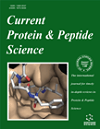Current Protein and Peptide Science - Current Issue
Volume 26, Issue 4, 2025
-
-
TLR4 Targeting: A Promising Therapeutic Approach Across Multiple Human Diseases
More LessAuthors: Sakshi Kumar, Vikram Sharma and Shikha YadavTLR4 stands at the forefront of innate immune responses, recognizing various pathogen-associated molecular patterns and endogenous ligands, thus serving as a pivotal mediator in the immune system's defense against infections and tissue damage. Beyond its canonical role in infection, emerging evidence highlights TLR4's involvement in numerous non-infectious human diseases, ranging from metabolic disorders to neur Read More
-
-
-
Unraveling APOE4's Role in Alzheimer's Disease: Pathologies and Therapeutic Strategies
More LessAuthors: Siddhant Tripathi, Yashika Sharma and Dileep KumarAlzheimer's disease (AD), the most common kind of dementia worldwide, is characterized by elevated levels of the amyloid-β (Aβ) peptide and hyperphosphorylated tau protein in the neurons. The complexity of AD makes the development of treatments infamously challenging. Apolipoprotein E (APOE) genes’s ɛ4 allele is one of the main genetic risk factors for AD. While the APOE gene's ɛ4 allele considerably inc Read More
-
-
-
Human Paraoxonase 1: From Bloodstream Enzyme to Disease Fighter & Therapeutic Intervention
More LessHuman paraoxonase 1 (hPON1) is a Ca2+-dependent metalloenzyme with multifunctional properties. Due to its diverse activities (arylesterase, phosphotriesterase, and lactonase), it plays a significant role in disease conditions. Researchers across the globe have demonstrated different properties of PON1, like anti-oxidant, anti-inflammatory, anti-atherogenic, anti-diabetic, and OP-neutralization. Due to its pleotropic role i Read More
-
-
-
Cysteine Peptidases of Calotropis procera (Apocynaceae): A Literature Review on their Biochemical Properties and Potential Applications
More LessThe latex of the xerophytic plant Calotropis procera, popularly known as giant milkweed, contains a complex mixture of secondary metabolites and proteins and has attracted the attention of many researchers. Several bioactive laticifer enzymes from C. procera have been studied for their potential applications in the medical, agricultural and food industries. The present work aimed to review the current scientific knowledge Read More
-
-
-
Purification, Characterization, and Antimicrobial Activity Against Candida parapsilosis and Staphylococcus aureus of a Highly Stable Type-1 Cystatin from Terminalia catappa L. Seeds
More LessIntroductionClinic infections caused by various microorganisms are a public health concern. The rise of new strains resistant to traditional antibiotics has exacerbated the problem. Thus, the search for new antimicrobial molecules remains highly relevant.MethodsThe current study purified, characterized, and assessed the antimicrobial activity of a papain inhibitor from Terminalia catappa L. seeds.ResultsThe inhibito Read More
-
Volumes & issues
-
Volume 26 (2025)
-
Volume 25 (2024)
-
Volume 24 (2023)
-
Volume 23 (2022)
-
Volume 22 (2021)
-
Volume 21 (2020)
-
Volume 20 (2019)
-
Volume 19 (2018)
-
Volume 18 (2017)
-
Volume 17 (2016)
-
Volume 16 (2015)
-
Volume 15 (2014)
-
Volume 14 (2013)
-
Volume 13 (2012)
-
Volume 12 (2011)
-
Volume 11 (2010)
-
Volume 10 (2009)
-
Volume 9 (2008)
-
Volume 8 (2007)
-
Volume 7 (2006)
-
Volume 6 (2005)
-
Volume 5 (2004)
-
Volume 4 (2003)
-
Volume 3 (2002)
-
Volume 2 (2001)
-
Volume 1 (2000)
Most Read This Month Most Read RSS feed
Article
content/journals/cpps
Journal
10
5
false
en


